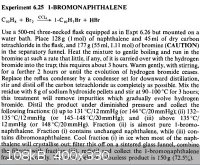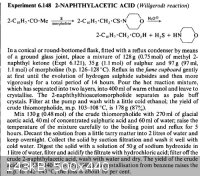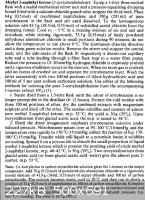Waffles SS
Fighter
   
Posts: 998
Registered: 7-12-2009
Member Is Offline
|
|
Naphthaleneacetic acid Synthesis
| Quote: |
1-Naphthaleneacetic acid (NAA) is an organic compound with the formula C10H7CH2CO2H. This colorless solid is soluble in organic solvents. It features
a carboxylmethyl group (CH2CO2H) linked to the "1-position" of naphthalene.
http://en.wikipedia.org/wiki/1-Naphthaleneacetic_acid
|
Does Friedel Crafts of MCA(Mono Chloro Acetic Acid)and Naphthalene Lead to NAA?There are any simpler way?
[Edited on 28-4-2013 by Waffles SS]
|
|
|
ScienceSquirrel
International Hazard
    
Posts: 1863
Registered: 18-6-2008
Location: Brittany
Member Is Offline
Mood: Dogs are pets but cats are little furry humans with four feet and self determination! 
|
|
See here;
http://pubs.acs.org/doi/abs/10.1021/ja01165a533
|
|
|
Nicodem
|
Thread Moved
5-5-2013 at 11:58 |
Waffles SS
Fighter
   
Posts: 998
Registered: 7-12-2009
Member Is Offline
|
|
It seems cheaper and more dangerous way will be
First Chloro Methylation of Naphthalene
http://www.orgsyn.org/orgsyn/orgsyn/prepContent.asp?prep=cv3...
and then Making Naphthalene acetonitrile and finally hydrolysis by acid to form 1-Naphthalene acetic acid.
Making Naphthaleneacetonitrile is possible by reacting of Sodium/Potassium Cyanide to chloromethylnaphthalene (same as Benzyl cyanide from benzyl
chloride).I want to know this reaction happen fast or slow?how can i improve yield?
[Edited on 9-5-2013 by Waffles SS]
|
|
|
ScienceSquirrel
International Hazard
    
Posts: 1863
Registered: 18-6-2008
Location: Brittany
Member Is Offline
Mood: Dogs are pets but cats are little furry humans with four feet and self determination! 
|
|
That may be the best approach.
I suspect that a quick literature review will pull up well tested preparations that should be easy to repeat.
I would not describe chloromethylation or reaction with cyanide as dangerous if you have a good fume hood and reasonable technique.
|
|
|
DraconicAcid
International Hazard
    
Posts: 4278
Registered: 1-2-2013
Location: The tiniest college campus ever....
Member Is Offline
Mood: Semi-victorious.
|
|
Quote: Originally posted by ScienceSquirrel  | That may be the best approach.
I suspect that a quick literature review will pull up well tested preparations that should be easy to repeat.
I would not describe chloromethylation or reaction with cyanide as dangerous if you have a good fume hood and reasonable technique.
|
If you're paranoid about cyanide, you can probably make a Grignard reagent with the chloromethylnaphthalene and react it with carbon dioxide.
Please remember: "Filtrate" is not a verb.
Write up your lab reports the way your instructor wants them, not the way your ex-instructor wants them.
|
|
|
Waffles SS
Fighter
   
Posts: 998
Registered: 7-12-2009
Member Is Offline
|
|
Another possible route will be reacting 1-Naphthylmagnesium bromide(Grigniard reagent) with Chloroacetic acid
US2290401(But not certain detail about yield)
Somebody has experience on making 1-Bromo Naphthalene ?

Vogel 5TH Page863
Attachment: US2290401A.pdf (86kB)
This file has been downloaded 519 times
[Edited on 10-5-2013 by Waffles SS]
|
|
|
ScienceSquirrel
International Hazard
    
Posts: 1863
Registered: 18-6-2008
Location: Brittany
Member Is Offline
Mood: Dogs are pets but cats are little furry humans with four feet and self determination! 
|
|
1-Naphthylmagnesium bromide will react with chloroacetic acetic acid to give you you napthalene.
|
|
|
Waffles SS
Fighter
   
Posts: 998
Registered: 7-12-2009
Member Is Offline
|
|
This mean US2290401 is Bullshit?
|
|
|
ScienceSquirrel
International Hazard
    
Posts: 1863
Registered: 18-6-2008
Location: Brittany
Member Is Offline
Mood: Dogs are pets but cats are little furry humans with four feet and self determination! 
|
|
I would be a little dubious about that patent.
If you have a look at it the maximum yield you can achieve is 50%.
The first reaction is to form napthalene and magnesium bromide chloroacetate, as I said above.
So half of your Grignard reagent is consumed doing this.
The magnesium bromide chloroacetate then reacts with the remaining Grignard to form napthylacetic acid.
Worth a try if you have the reagents to hand and want to make a few grams but it is not the cheapest or the best way.
|
|
|
Waffles SS
Fighter
   
Posts: 998
Registered: 7-12-2009
Member Is Offline
|
|
What is your suggestion?what method you prefer?
|
|
|
ScienceSquirrel
International Hazard
    
Posts: 1863
Registered: 18-6-2008
Location: Brittany
Member Is Offline
Mood: Dogs are pets but cats are little furry humans with four feet and self determination! 
|
|
If I wanted a few grams and I had a source available I would buy it.
It is moderately available from all sorts of places, put a watch on it on eBay for example and it will turn up in a few months.
If you can access a research chemical supplier or someone who acts as reseller then you can just order it.
I suspect that professional nursery and hydroponics suppliers can supply it also.
If I had to make a few grams, I would go for either the Friedel Crafts or the Grignard reaction.
If I wanted kilos and I had the time I would go for bromomethylation on a research scale or chloromethylation on an industrial scale, reaction with
cyanide and hydrolysis.
It is a three step process but optimised I reckon you could do better than 90% on each stage, it is highly atom efficient with cheap reagents and will
produce very little 'glop'.
|
|
|
Waffles SS
Fighter
   
Posts: 998
Registered: 7-12-2009
Member Is Offline
|
|
Ethyl α-Naphthoate prepare by reaction of α-naphthylmagnesium bromide with Diethyl carbonate.I think this should be possible for
1-Naphthaleneacetic acid, methyl ester by reaction of 1-(Magnesium Chloromethyl) Naphthalene with Dimethyl Carbonate.am i wrong?
|
|
|
Waffles SS
Fighter
   
Posts: 998
Registered: 7-12-2009
Member Is Offline
|
|
Naphthyl Acetic Acid by Willgerodt reaction

Vogel 5th
Naphthyl Methyl Ketone

Vogel 5th
| Quote: |
Naphthyl Methyl Ketone
(1) Acetic anhydride (20.4 g.; 1 mol.) was gradually added to a well stirred mixture of aluminium
chloride (56 g. ; 2 mols.) in ethylene chloride (100 c.c.). After 3 hours stirring, a solution of naphthalene
(25.6 g.) in ethylene chloride (50 c.c.) was gradually added. The temperature was kept at 35c during
the addition, but was subsequently raised to 50c to complete the reaction. After decomposition with
dilute hydrochloric acid the product provided a fraction (20 g.; b. p. 163c/15 mm.; m. p. 9.0 and
mixed m. p. 9.5 with pure a-naphthyl methyl ketone) which was almost pure a-naphthyl methyl
ketone. Picrate analysis indicated 97.5% of a-ketone.
(2) A solution of acetyl chloride (8 g. ; 1 mol.) and aluminium chloride (14 g. ; 1 mol.) in ethylene
chloride (30 c.c.) was gradually added to a solution of naphthalene (13 g.) in ethylene chloride (30 c.c.)
at 35c. A ready reaction occurred, and a solid separated. The mixture was decomposed with dilute
hydrochloric acid, and the product provided a fraction (16 g. ; b. p. 163c/15 mm. ; m. p. 9.0c and mixed
m. p. 9.5 with pure a-naphthyl methyl ketone) which was almost pure a-naphthyl methyl ketone.
Picrate analysis indicated 98% of a-ketone. A similar result was obtained when the solution of naphthalene
was gradually added to the solution of acetyl and aluminium chlorides.
The acylation of naphthalene by the friedel–crafts reactionG. BaddeleyJ.
Chem. Soc.1949, S99-S103
DOI: 10.1039/JR9490000S99
|
It seems this is possible to make 1-Naphthyl Acetic Acid by Willgerodt reaction,and also Naphthyl Methyl Ketone by FC.
Unfortunately i dont have access to anhydrous AlCl3 and i dont want to work with CCl4.I know FeCl3 is another possible catalyst for FC but i dont know
this is effective in this reaction or not?.I want to acylation of Naphthalene by F3Cl3 as catalyst and Methylene Chloridei(CH2Cl2) as solvent(like
above reaction).Somebody has experience on these reactions?
[Edited on 21-6-2013 by Waffles SS]
|
|
|
Furboffle
Harmless

Posts: 46
Registered: 15-10-2012
Member Is Offline
Mood: No Mood
|
|
Idk if you just really wanna make it. But check out Caisson Labs. They focus on stuff for cell cultures but sell naphthalene acetic acid as a culture
nutrient. Pretty cheap 100g for 25$.
I ordered indole acetic acid from them and they sent me a goody back with 5g indole butyric acid, 5g naphthalene acetic acid and a bunch of murshige
and skoog as if I'm trying trying to do some cell culture project. Cheap and great customer service.
[Edited on 21-6-2013 by Furboffle]
|
|
|
Zephyr
Hazard to Others
  
Posts: 341
Registered: 30-8-2013
Location: Seattle, WA
Member Is Offline
|
|
I've recently attempted a synthesis of NAA using the procedure waffles linked.
Here are some photos:



The above pictured crystals are just a small test portion of the total batch.
The total 8g of dirty brown goop was recrystallized twice, total yield 4.5g, about 35%.
I'm very interested in synthesizing and comparing the effects of IAA. Does anyone know if The same synthesis can be used by just switching the
naphthalene with indole? Or possibly of source of indole more affordable than elemental scientific?
Ps. sorry to dredge up this old thread.
|
|
|
Waffles SS
Fighter
   
Posts: 998
Registered: 7-12-2009
Member Is Offline
|
|
Which method you used?
For IAA try first :
Synthesis Indole-3-acetonitrile by Cyanomethylation of Indole with Diethylaminoacetonitrile
(https://erowid.org/archive/rhodium/chemistry/diethylaminoace...)
Then hydrolysis Indole-3-acetonitrile by 20% KOH soultion
[Edited on 9-4-2015 by Waffles SS]
|
|
|
Zephyr
Hazard to Others
  
Posts: 341
Registered: 30-8-2013
Location: Seattle, WA
Member Is Offline
|
|
I used the chloroacetic acid and naphthalene with iron oxide and potassium bromide as catalysts.
I could do that synthesis, but I would prefer to try an easier one first.
|
|
|
Waffles SS
Fighter
   
Posts: 998
Registered: 7-12-2009
Member Is Offline
|
|
Please let us know the deatils.
I attached Reaxys search of IAA and NAA.you can find another interesting method for synthesis IAA and NAA.
I have experience on synthesis of Auxins(IAA , NAA ,IBA,PAA) and will share with you.
I think my suggest method is one of the easier method for synthesis IAA.
(also you can follow Inole synthesis in below topic:
http://www.sciencemadness.org/talk/viewthread.php?tid=13152)
Attachment: IAA reaxys search.pdf (357kB)
This file has been downloaded 846 times
Attachment: NAA reaxys search.pdf (336kB)
This file has been downloaded 1581 times
[Edited on 9-4-2015 by Waffles SS]
|
|
|
Zephyr
Hazard to Others
  
Posts: 341
Registered: 30-8-2013
Location: Seattle, WA
Member Is Offline
|
|
I vaguely followed this procedure for both of my syntheses:
http://pubs.acs.org/doi/abs/10.1021/ja01165a533
*just realized this was sciencesquirrels not waffles
For my first synthesis I messed with the catalysts a little, using iron oxide and sodium bromide instead of potassium bromide.
For this synthesis I used a 3g of chloroacetic acid and 12g of naphthalene. I refluxed this for four hours at 190C, but when I washed the resulting
black glob I used a vast over excess of NaOH solution (amount was not specified in the procedure). As a result I need a lot of hydrochloric acid to
neutralize the solution, and at this point I had ~500ml of neutralized solution with very little precipitate. I filter and got a tiny amount, not
nearly enough to recrystallize.
My second try was much more successful, and it is where the photos are from. The procedure remained essentially the same, except I used the
recommended catalysts, refluxed for eight hours and at 210C, and only washed with 3 50ml portions of 1/2 molar NaOH solution, after neutralization
ending up with ~200ml of solution. These improvements allowed a much better yield.
I plan on doing a larger version of this in order to receive enough NAA to use it for experimenting on plants.
Ps. is it just me or are superscripts not working???
|
|
|
Waffles SS
Fighter
   
Posts: 998
Registered: 7-12-2009
Member Is Offline
|
|
I tried this method X100 your scale but i was unsuccessful.I got 10-15gr grey powder that dont seems to be NAA
I was successful in synthesis of NAA by Willgerodt reaction(according to my above procedure) but this methos has several step and make NAA more
expensive.
I want to try MCA + Naphthalene method again.
[Edited on 11-4-2015 by Waffles SS]
Attachment: The Role of Chloroacetylpolyglycolic Acids.pdf (564kB)
This file has been downloaded 430 times
Attachment: US1951686A.pdf (150kB)
This file has been downloaded 394 times
Attachment: US2617822A.pdf (707kB)
This file has been downloaded 461 times
|
|
|
Zephyr
Hazard to Others
  
Posts: 341
Registered: 30-8-2013
Location: Seattle, WA
Member Is Offline
|
|
I hope you tried recrystallizing the grey powder? Prior to recrystallization I had brown mud.
|
|
|
Waffles SS
Fighter
   
Posts: 998
Registered: 7-12-2009
Member Is Offline
|
|
Yes i did it.
I am not sure about my Iron(III)Oxide,that was industrial grade and i am looking for lab grade sample
Do you have pic from your brown mass?
[Edited on 12-4-2015 by Waffles SS]
|
|
|
woelen
|
Thread Moved
14-4-2015 at 23:43 |
woelen
Super Administrator
        
Posts: 7977
Registered: 20-8-2005
Location: Netherlands
Member Is Offline
Mood: interested
|
|
Moved thread after request. This thread is beyond beginner-level and organic chemistry seems to be a proper place for it.
|
|
|
Zephyr
Hazard to Others
  
Posts: 341
Registered: 30-8-2013
Location: Seattle, WA
Member Is Offline
|
|
Yes, here is a picture of the brown gunk prior to recrystallization:

|
|
|